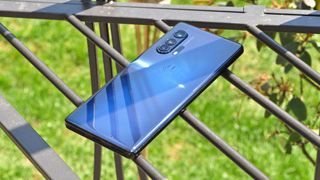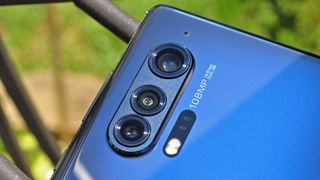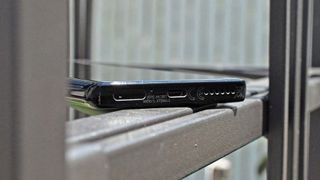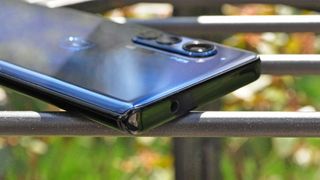Tom's Guide Verdict
The Motorola Edge Plus is a solid all-around flagship with booming speakers and a headphone jack audiophiles will love. But its cameras, battery and software are unremarkable, and it’s tied to Verizon, making it a tough sell compared to the Galaxy S20 and OnePlus 8 series.
Pros
- +
Nice display
- +
Great performance
- +
Headphone jack
- +
Booming audio
- +
Supports mmWave 5G
Cons
- -
Verizon exclusive
- -
No IP water resistance rating
- -
Slow charging speed
Why you can trust Tom's Guide
The Motorola Edge Plus feels like a statement of intent from a company that has everything to prove when it comes to high-end phones. After several years of staying out of the flagship phone arms race — all the while committed to churning out very respectable-albeit-uninspiring budget devices — the company is finally delivering a $1,000 phone that it believes will take the fight to the Samsung Galaxy S20, OnePlus 8 Pro and iPhone 11 Pro.
To Motorola’s credit, the Motorola Edge Plus seems to have pretty much everything you could ask for in a flagship phone in 2020, between its wraparound 6.7-inch, 90-Hz OLED display, gigantic 5,000-mAh battery and quad-lens camera array that even borrows the Galaxy S20 Ultra’s 108-megapixel primary shooter.
It’s also a Verizon exclusive, in true Motorola fashion. That always stings, but it’s especially painful this time around, because the Edge Plus is the most exciting handset to come out of the Chicago-based phone maker in a long time.
Excitement alone doesn’t earn any phone a recommendation. And while there are certainly aspects to like about this device, as you’ll find in our Motorola Edge Plus review, there are other flagships out there that present a more complete package, deliver more for less or can be used on any carrier of your choice. Good though the Edge Plus is, it’s not quite up the standards set by the best phones.
Motorola Edge Plus review: Pricing and availability
The Motorola Edge Plus costs $999. Like so many of its Droid-branded predecessors, it will be exclusive to Verizon’s network in the U.S.
Motorola also sells a cheaper model, just called the Motorola Edge, that's now available unlocked and on other carriers. However, that phone swaps out the Edge Plus’ Snapdragon 865 processor for a lower-spec Snapdragon 765 CPU, and make some other specs concessions to achieve its lower $699 price. The cheaper Motorola Edge can still connect to 5G networks, though.
Price: $999
OS: Android 10
Display: 6.7-inch OLED (2340x1080; 90 Hz)
CPU: Snapdragon 865
RAM: 12GB
Storage: 256GB; expandable
Rear camera: Quad-lens: 108MP wide (ƒ/1.8), 16MP ultrawide (ƒ/2.2), 8MP 3x telephoto (ƒ/2.4), time-of-flight VGA
Front camera: 25MP (ƒ/2.0)
Battery: 5,000 mAh
Carriers: Verizon only
5G: Sub 6-GHz, mmWave
Size: 6.34 x 2.81 x 0.37 inches
Weight: 7.16 ounces
As for the Edge Plus, it comes in one configuration, with 256GB of UFS 3.0 storage and 12GB of superfast LPDDR5 RAM. Both of those specs equal the OnePlus 8 Pro, which costs $100 less than the Edge Plus will. But since the Edge Plus will be offered by Verizon, Motorola’s phone has been developed to support the full range of Big Red’s network, including its high-speed millimeter-wave 5G infrastructure — something the OnePlus 8 Pro cannot claim.
Motorola Edge Plus review: Design
The name of Motorola’s new flagship is derived from its display, and it’s that display that informs most of the Edge Plus’ design. Motorola has dubbed this an “Endless Edge” panel, because it curves a full 90 degrees around the left and right sides of the phone. It’s sort of like the screen on the new OnePlus 8 Pro, except more extreme.

In fact, the curve on this display is the most dramatic we’ve ever seen, on any phone. Holding the Edge Plus in your hand, you begin to worry about inadvertently interacting with the screen when you don’t mean to. Fortunately, Motorola has tuned the palm-rejection software well enough that I didn’t find myself accidentally triggering items on the fringes of the screen.
That’s a good start then — but is the curve actually useful? That’s a tougher question to answer. Phone makers have been experimenting with curved panels for a long time, though the benefits have never been clear. The Edge Plus utilizes the sides of its display for two purposes: as a place to stash additional shortcuts, and to convey battery status and notifications visually, particularly when the screen is off.

The shortcuts are handy, though hardly game changing. This feature, called Swipe In, works exactly how it says on the tin — you swipe inward on a tab along the right side, and six tasks or apps show up. You can customize this list how you like, and to Motorola’s credit, it’s much more responsive and easier to trigger than Sony’s infuriating Side Sense functionality on its Xperia devices, which is supposed to work in a similar fashion yet fails about half the time.

Curve aside, though, the Edge Plus is actually a very distinctive-looking flagship. Between its sharp corners, super-narrow 21:9 proportions and prominent pill-shaped rear camera module, there’s never really been a Motorola phone like it before. It sort of resembles the Samsung Galaxy Note 10 Plus, except taller and chunkier, owing to its larger battery. The Edge Plus is a hair heavier than Samsung’s phablet too, by about a quarter of an ounce.
I’d hesitate to call the Edge Plus elegant, though. Our review unit is Thunder Grey — though it’s really more of a steel blue hue — and looks nice enough from the back. But the super-thin frame sandwiched between the two glass panels is painted a glossy black, which is more evocative of cheaper handsets and doesn’t really mesh with the satiny cool luster of the rear.

Along the top and bottom, the frame flares out and bows in down the middle in an unusual way. Weirdly, Motorola shoehorned all the regulatory labels, like the phone’s model number and CE logo, into that lower part of the frame between the SIM card tray, speaker grille and USB Type-C port. It’s almost like they forgot to include them and were forced by law to scramble and etch them in at the last minute.
One final point on the Edge Plus’ design, and it’s a downer: Motorola has neglected to make this device IP-certified water resistant, which is actually pretty rare these days. Nearly all high-end models from all the major phone makers can be submerged without damage, but the Edge Plus only boasts protection against spills and splashes.
Motorola Edge Plus review: Display
High refresh-rate, full-HD OLED displays have gone from a luxury to the status quo for Android flagships. The Motorola Edge Plus falls in lockstep with that trend, thanks to a 90Hz panel that offers fluid scrolling and increased responsiveness to taps and gestures.
In terms of smoothness, 90Hz is better than the 60Hz of traditional displays, but not quite as slick as the 120Hz offered by the Galaxy S20 line and OnePlus 8 Pro. The Google Pixel 4 and the regular OnePlus 8 also tout 90Hz panels.

The Motorola Edge Plus features a big screen, though it conceals its size well. Technically, it measures 6.7 inches from corner to corner — which seems quite unwieldy, until you factor in the curves on either side, and the narrow 21:9 aspect ratio, both of which improve ease of use with one hand.
The Edge Plus’ panel is a pretty one too, even if it’s not among the brightest we’ve tested. The screen in Motorola’s flagship peaked at 550 nits under our light meter. That’s decent, though it’s several hundred nits less than what Moto’s fiercest rivals offer, like the iPhone 11 Pro (752 nits) or the Galaxy S20 (857 nits).

When it comes to general display quality and color, though, the Edge Plus is on point. Watching the trailer for F9, the upcoming Fast & Furious film, I remarked at the lush greens and clouds of uprooted earth as Jakob Toretto — John Cena’s character — bounded his Shelby Mustang across a tropical forest and off a mountain cliff. The cinematic aspect ratio made the clip especially captivating, because it immersed the action in a wider context, with Toretto’s pony car looking so small amidst the dust, debris and explosions flying about from every direction. The Edge Plus’ display is an ideal one for watching movies.
Motorola’s flagship rendered 134.5% of the DCI-P3 color space on its default Saturated setting, which sits it between the OnePlus 8 Pro (116.9%) and Samsung Galaxy S20 Plus (162.5%). If you’re looking for more realistic color, there are Boosted and Natural options as well, with the latter tuned to deliver sRGB coverage.
Bold as the Edge Plus’ hues are, it’s not the most accurate panel we’ve tested in terms of color reproduction. While set to its most-lifelike Natural profile, the best the phone could offer in our Delta-E test was a 0.29 result. In this particular benchmark, numbers closer to zero are preferred, and the OnePlus 8 Pro (0.26) and iPhone 11 Pro (0.28) fared slightly better, while the Samsung Galaxy S20 Plus actually lagged behind the pack (0.36).
Motorola Edge Plus review: Camera
Motorola has never been particularly renowned for its cameras, but the Edge Plus looks to change that reputation for the better. Motorola makes the effort with a quad-lens rear camera system that interestingly utilizes the very same 108MP sensor found in the $1,399 Galaxy S20 Ultra. Here, though, you can have it in a device that costs $400 less.

As for the other cameras on the Edge Plus, they comprise an 8MP telephoto capable of 3x optical zoom, a 16MP ultrawide lens and a time-of-flight depth sensor, which is inconspicuous hiding in the strip adjacent to the flash.
Motorola is very proud of what the Edge Plus can accomplish with that main 108MP optic, though. Like a few of the company’s past phones, the Edge Plus utilizes quad-pixel binning, which in this case results in 27-MP shots with optimal exposure and dynamic range that should be especially useful in low light. While the 108MP option is always available to you, more often than not you’re better off sticking with the default option to benefit from all of Motorola’s computational photography tricks, unless you really need those thousands of extra pixels for cropping after the fact.
The Edge Plus’ photos are generally good, but sometimes exhibit a narrow range of focus. In capturing the wreath of flowers you see above, Motorola’s camera ever so slightly blurs some of the petals at the perimeter. While I like the added clarity the Edge Plus lends to the darker, more shadowy portions of the image, its rendition unfortunately lacks the vivid hues — particularly the lush lavender — present in the iPhone 11 Pro’s shot.
The Edge Plus can suffer from trouble dealing with highlights, as this shallow depth-of-field portrait demonstrates. While the image overall is quite good — and I actually like that Motorola’s software subtly dims the background, to allow the model to stand out more — the sunlight is totally blown out, and particular details, like the fabric of the woman’s shirt, are fuzzier.
In comparing ultrawide photos between Motorola and Apple’s flagships, it’s easy to see that the Edge Plus’ zoomed-out shooter sports a narrower field-of-view than the one inside the iPhone 11 Pro’s. There are certain advantages to this, as the line of trees in the distance is generally sharper through the Edge Plus’ lens, compared to the iPhone’s. But if the purpose of an ultrawide vantage point is to really pull back as far as you can, the iPhone’s optic is more useful. Additionally, the white balance of the Edge Plus’ shot is a tinge too warm, and Motorola’s flagship seemed to have a bit more trouble resolving those brighter, blown out areas of the image, like the side of the shed to the right.
I came away more impressed by the Edge Plus’ rendition of this image of a tree from a distance on a cloudy day, taken with its 3x optical lens. While the Galaxy S20 Plus’ lighting is probably a bit more accurate, I prefer just about everything else in the Edge Plus’ attempt. The tree is much sharper and brighter, with slightly punchier colors that catch the eye without venturing into oversaturation. The details on the house in the background are more precise as well, and there’s less of a blur when you peer in on the street sign to the right.
However, when I used the same two phones to cut in close on a pair of model cars, the Edge Plus’ shot turned out to be a bit of a let down. While Samsung’s algorithms have a known tendency to over-sharpen images and heavily bolden edges, at least the S20 Plus’ version of things is in focus. The Edge Plus got the colors right, but everything else turned out to be a smeary mess, with a haze applied to blown-out regions of the frame despite the fact tap-to-focus was used in both instances.

It’s a shame, because sometimes, the Edge Plus can pick up phenomenal detail. The ultrawide lens doubles as a macro shooter when used with the corresponding mode, and it can churn out some pretty impressive results, like this dive into a leaf. Look at the way the plant’s texture catches and manipulates light at the granular level, and those drops of dew sitting delicately in place to the right. I’m not usually one to take advantage of macro modes in phone cameras, but the Edge Plus has made me want to experiment with them.
Motorola’s Night Vision mode is pretty decent as well, to its credit. The Pixel 4 is my favorite low-light shooter, but I think I’m more pleased with the way the Edge Plus captured this cozy fireplace scene. The Pixel 4’s attempt is brighter overall, but the Edge Plus’ shot is much sharper — something you especially see in the links of the chain mesh, the embers below and the bricks inside. On the other hand, there’s a warmth and color to the way Google’s software painted this scene that I miss in the Edge Plus’ version, though it’s not a huge loss.
Finally, we turn to the Edge Plus 25MP front-facing camera, which also incorporates quad-pixel binning to let as much light in as possible. In spite of that, though, I’m more pleased with the iPhone 11 Pro’s self-portrait. It’s sharper, my winter hat is clearly more in focus, and my skin tone, the shadows and the color overall is simply more natural across the board. Looking at my Edge Plus selfie long enough, I start to worry I might have jaundice.

The Edge Plus offers the ability to capture 20MP stills as you’re recording from the main camera, and the company promises the resulting shots aren’t compressed screenshots of recorded videos — rather, they’re full-resolution images that rival what you’d be able to get if you were snapping photos under normal circumstances. In our testing, we found that to be true; while the video snapshots had slightly more grain to them, the dynamic range and detail was comparable to an identical photo snapped normally.
Motorola Edge Plus review: Sound
You’ll find a curious-yet-welcome feature along the top of the Edge Plus: a headphone jack. Motorola says it brought the 3.5-millimeter port back due to consumer feedback. That’s commendable, considering most phone makers that have ditched the jack in their high-end models haven’t gone back on their decisions.

Even if you don’t take advantage of that audio port, though, Motorola says it poured lots of attention into the Edge Plus’ stereo speakers to make them the loudest ever in a smartphone — and you can tell. This phone gets exceptionally loud, putting the iPhone 11 Pro to shame in terms of volume while also offering a bit more low-end oomph.
Some songs, like Death Cab for Cutie’s classic, “For What Reason,” definitely allow that sense of warmth and added richness to shine. The guitars in that track occasionally sound like they’ve been submerged underwater — a style that most handsets often fail to convey, with their tinny speakers. The Edge Plus plunges those licks deeper into the pool, while allowing vocalist Ben Gibbard’s chorus to soar ever higher.
Other times, the Edge Plus’ audio advantages are more subtle. Listening to Madvillian’s “Raid,” the jazzy piano, hissing cymbals and MF Doom’s crisp verses benefit from a live presence you probably wouldn’t expect from phone speakers — yet that track is so well produced, it already sounds phenomenal on just about anything.
The Edge Plus owes its expert tuning to a company called Waves Audio, which Motorola tasked to ensure the quality of the phone’s sound could match its loudness. Waves has done an excellent job. And while I personally think most smartphone buyers especially concerned about audio quality should turn to one of the best Bluetooth speakers when they want to enjoy their tunes, the power of the Edge Plus’ drivers ensure you won’t feel totally helpless without your listening device of choice.
Motorola Edge Plus review: Performance and 5G
Like many other Android flagships, the Edge Plus benefits from Qualcomm Snapdragon 865 power. With 12GB of speedy LPDDR5 RAM, we expected this phone would fly, and fly it does.
Asphalt 9 Legends is a popular mobile racing game we often play during most of our phone reviews here at Tom’s Guide. That’s both because it’s one of the most graphically demanding titles on both Android and iOS, and because, in my experience, no phone has ever run it flawlessly. Even flagships suffer the odd dropped frame here or there, but the Edge Plus might be the first to pass the test with flying colors. In one race in the Himalayas, falling rock and debris tumbles into the road as you’re driving; I don’t ever recall that particular environmental hazard unfolding quite as smoothly — without no framerate hit to speak of — as it does on Moto’s new flagship.

In the system-wide multicore Geekbench 5 test, the Edge Plus delivered a score of 3,350 points, landing just behind the OnePlus 8 Pro (3,379) and a bit further behind the iPhone 11 Pro (3,517). Additionally, in the OpenGL version of GFXBench’s Aztec Ruins graphic test for high-tier devices, the Edge Plus notched a respectable 20 frames per second, which was dead even with the performance of OnePlus’ flagship.
As a real-world test, we task devices with converting a short 4K video to 1080p using Adobe’s Premiere Rush app, and then clock the time spent to finish the job. It took 1 minute and 32 seconds for the Edge Plus to turn that clip around, which happened to be 11 seconds less time than the OnePlus 8 Pro needed, with its 8GB of RAM to the Edge Plus’ 12GB. The iPhone 11 Pro, however, smoked both devices (as it typically does in this test), requiring only 45 seconds to transcode the very same file.
The Edge Plus’ performance story, then, is encouraging but also predictable, given the processor inside and all the memory Motorola supplied that silicon with. What’s more interesting is the work the company has done on the 5G side of things.
Motorola claims the Edge Plus is the fastest 5G phone in the world, thanks to a unique antenna array and clever tuning by the company’s engineers. It is a somewhat vague claim, it has to be said, as the company doesn’t cite live data speed comparisons against other 5G phones to support that assertion.
For what it’s worth, Motorola says the Edge Plus was able to record just over 4 Gbps downlink in a “simulated” 5G mmWave environment, though current 5G networks cannot deliver that kind of performance today. Additionally, because of the ongoing coronavirus pandemic and the limited range of mmWave networks, we’re not in a position to test the Edge Plus’ fastest download speeds against a competitor, like the Samsung Galaxy S20 Plus.
The Edge Plus will also support Verizon’s sub-6GHz 5G bands, as Verizon expands its 5G coverage later this year.
Motorola Edge Plus review: Battery and charging
Sized at 5,000 mAh, the battery inside the Edge Plus is one of the largest you’ll find in any phone today. To put that into perspective, it’s 500 mAh larger than the batteries the OnePlus 8 Pro and Galaxy S20 Plus use, and equal in capacity to the battery inside the considerably more expensive Galaxy S20 Ultra.
Of course, the Edge Plus packs no shortage of power-draining features and hardware, between its speedy processor, mmWave radio and that fast-refresh, high-resolution display. In other words, even despite that beefy battery, this isn’t the longest-lasting phone on a charge — though it should still last long enough for most people.

Motorola’s flagship averaged a time of 10 hours and 55 minutes in Tom’s Guide’s custom battery test, where phones endlessly load a series of web pages over a data connection until they run out of juice. The Edge Plus ran the test a total of three times while set to its 60-Hz display mode for the best possible result.
Nearly 11 hours is very good, though not quite the best we’ve seen in this price range. The aforementioned OnePlus 8 Pro actually fared slightly better, pulling out an 11-hour, 5-minute average, likely on account of the fact it has less RAM to power and doesn’t connect to mmWave networks. A better comparison would likely be the Galaxy S20 Plus, whose 10:31 average the Edge Plus still topped by roughly half an hour.
When it’s time to juice back up, Edge Plus buyers will be pleased to know there’s both wireless and wired charging onboard, though the wired “fast” charging system only tops out at 18 watts. That’s nearly half the wattage of the OnePlus 8 Pro’s wired and wireless Warp Charge systems, and well below the 25-watt adapters Samsung ships with its flagships.
But, of course, a big battery needs an appropriately fast charging solution, and the Edge Plus plainly doesn’t have one. Motorola’s phone reached just 28% from empty after 30 minutes using the stock brick. Over that same timeframe, the OnePlus 8 Pro reached 63%. The Edge Plus isn’t a cheap device, but Motorola certainly cheaped out on the packaged adapter — or at least it didn’t do the math.
Motorola Edge Plus review: Software
Motorola has never really taken excessive liberties with modifying stock Android, and that’s largely true of the Edge Plus as well. The company has advertised a new software initiative beginning with this device, titled My UX, that allows users to customize visual aspects of their experience, like fonts and icons — though it’s largely based upon the theming engine that’s already baked into Android 10.

That’s probably for the better, though, as what few touches Motorola has exerted on Google’s operating system tend to be generally useful. There are the aforementioned audio enhancements, as well the Moto app that the phone maker loads onto all its devices, offering optional physical shortcuts to quick-launch the camera and flashlight. You don’t have to use them if you don’t want to, and they never get in the way.
Motorola has opted for an optical fingerprint sensor for authentication on the Edge Plus, and it works well. It’s not the fastest scan in the world, but I didn’t find it to be especially picky about orientation or pressure, and I didn’t experience many false negatives during my time with the phone. There’s actually a nice haptic “pop” that occurs when unlocking the Edge Plus, and it must be said that this device’s haptics are very pleasing overall, especially when typing.

The Edge Plus defaults to an unusual live wallpaper, depicting rolling waves from a top-down view as you scroll through home screen pages. Normally I wouldn’t call attention to a phone maker’s custom wallpaper, but this one is especially strange because it’s extraordinarily laggy at times. Occasionally it plays back with all the fluidity of a poorly-optimized GIF, and it’s far too low resolution to look nice on the Edge Plus’ crisp display. To make matters worse, when you’re not interacting with it, the water just kind of freezes in place — not a good look.
Thankfully, you can change that wallpaper; what you can’t change is the Edge Plus’ weak update roadmap. Motorola typically commits to only one major software upgrade for its devices, which is disheartening but unfortunately common in the realm of cheap Android phones in which Motorola typically operates.
But, of course, the Edge Plus is not a cheap Android phone. And when we asked the company if they were modifying that stance in this case, a spokesperson initially told us that while Motorola “does not have absolute commitment to numbers of upgrades, Edge consumers can expect security updates every other month and a quick upgrade to Android 11.”
Most devices in the Edge Plus’ price range receive two major Android updates over the course of their lives, and Google promises three for its Pixel phones. Even Samsung recently upped its support window to three years. So the fact that Motorola wouldn’t go on record and commit to two — especially when the Edge Plus’ software is so similar to stock Android, at least outwardly — was maddening.
Evidently, someone at Motorola felt the same, and shortly after reviews of the Motorola Edge Plus broke from various outlets, the company decided to bestow the Edge Plus with a second major update, to Android 12, later in its life. That's good news for Edge Plus owners; lets just hope the updates arrive without lengthy delays.
Motorola Edge Plus review: Verdict
It’s good to see Motorola pool all of its expertise and resources into a flagship phone for the first time in roughly half a decade. The issue is, outside of the Edge Plus’ audio features — particularly its booming speakers and headphone jack — I struggle to come up with reasons someone would choose it over similarly priced device.
Sure, the Edge Plus’ display is very nice, but so are the OnePlus 8 Pro’s and the Samsung Galaxy S20’s — and those phones’ panels get brighter, too. Likewise, the Edge Plus is a top performer, but those other Android phones are just as fast where it counts. (And that’s to say nothing of the A13 Bionic-powered iPhone 11 series, which continues to outpace the Snapdragon contingent despite packing a fraction of the RAM.) The Edge Plus’ cameras are solid also, but — well, you get the picture.
Now, Motorola’s flagship is reasonably priced, all things considered; it may not be a bargain, but remember that the Galaxy S20 Plus and S20 Ultra ask between $200 to $400 more for similar specs. Ordinarily, that’d make the Edge Plus an easy enough recommendation for any buyer interested in a Samsung alternative. But then it’s not, because you have to be on Verizon to use it. And the bonus of millimeter-wave 5G speeds when you’re in the right city at the right time doesn’t justify that exclusivity.
In this day and age when so many phones are available through multiple carriers as well as unlocked, it’s hard to imagine anyone switching to Big Red for an Android phone that, while powerful, shares so many features with so many other, similarly-priced Android phones. To overcome that barrier of entry, the Edge Plus needed to be exceptional — but it’s just merely good.
Adam Ismail is a staff writer at Jalopnik and previously worked on Tom's Guide covering smartphones, car tech and gaming. His love for all things mobile began with the original Motorola Droid; since then he’s owned a variety of Android and iOS-powered handsets, refusing to stay loyal to one platform. His work has also appeared on Digital Trends and GTPlanet. When he’s not fiddling with the latest devices, he’s at an indie pop show, recording a podcast or playing Sega Dreamcast.
-
MonkeyMonster Just picked one up yesterday as an upgrade from a Moto Z4 that I had the JBL MotoMod speaker attached to. Held onto that as long as I could for that alone. Great phone with 5g and Android 11 slated for 12 , BUT a GIANT step backwards for sound. Itty bitty built in baby speakers will never compare to bigger ones. It offends my ears to listen to it now.Reply

